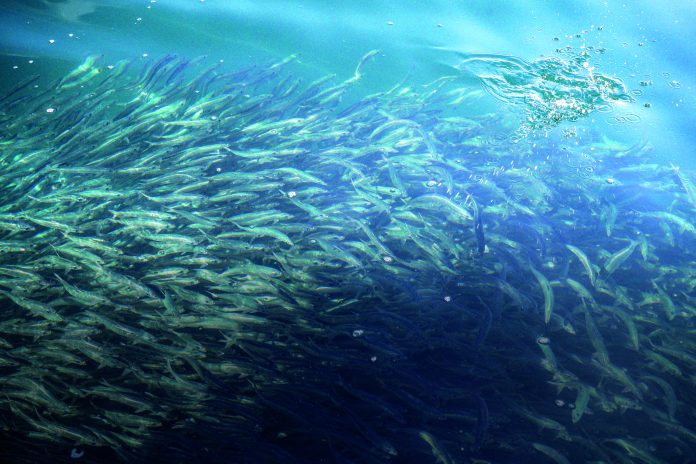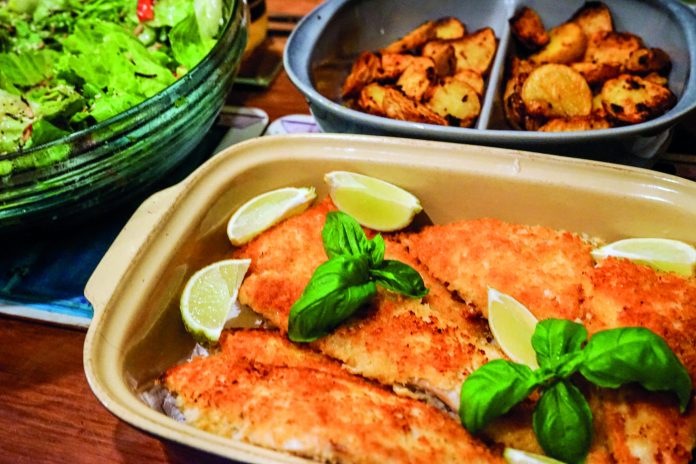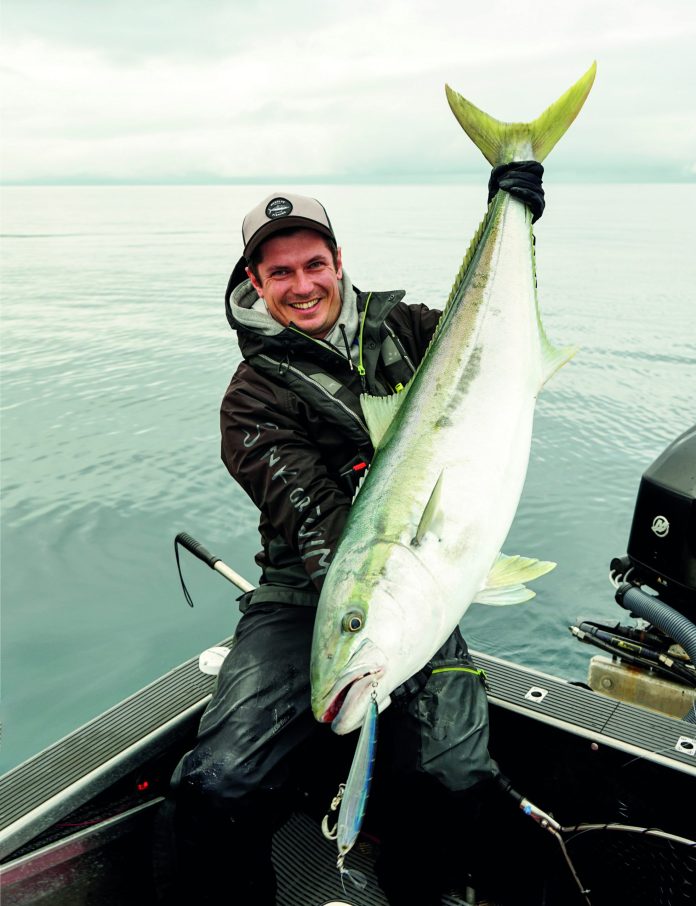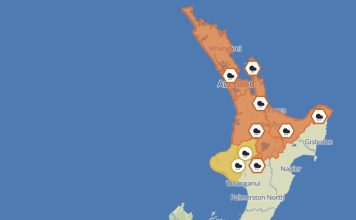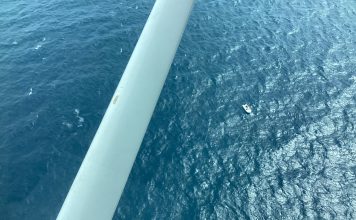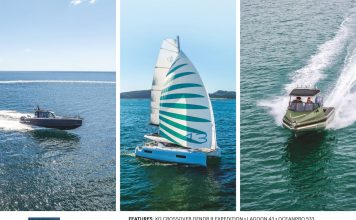As a youngster fishing the Wellington wharves, most of the time we were forced to use ‘sprats’ (yellow-eyed mullet, called ‘herrings’ down there), or, if we were luckier, a blue mackerel (‘slimy’). However, the more savvy and energetic anglers among us would trek around the shores and structures of the inner harbour to locate schools of pilchards. Initially we secured them using jags (large treble hooks), but in later years we embraced the power of sabiki bait flies.
Our fishing technique using pilchards as bait was simple: live ones were lobbed out to swim around under their own steam with
a 5/0-6/0 hook through their nostrils, while dead ones were hooked up through the skull, cast out (diagram 1) and slowly retrieved. We used flicks of our fingers on the disengaged spool of our trusty Penn Jigmaster 500 free-spool reels to retrieve the baits with an erratic jiggling, jerking motion that mimicked an injured baitfish. To great effect!

PHOTO: NZ FISHING NEWS
Meanwhile, those anglers fishing with sprats looked on enviously as we hauled in fish after fish – mostly kahawai and barracouta, except during the warmer months when we sometimes encountered kingfish too, along with the occasional sea-run brown trout.
Now, of course, we don’t need to catch pilchards ourselves since most fishing tackle shops and many service stations today stock packs of frozen pilchards in various quantities. Luxury.
Moving to Auckland helped me realise the pilchard’s full potential. Up here there are so many different fishing scenarios I can exploit using the almost magical powers of a pilchard bait.
Here are some of them…
Stray-lining with whole pilchards
This is definitely my favourite technique, and it’s just as effective off the shore as it is from a boat.

It’s a technique best used when there’s some current, as fish bite better then. Experiment to determine what weight ball sinker to use so that the bait drifts and sinks as naturally as possible, changing it up or down as the tidal flow changes. Fishers who adapt to the changing conditions tend to catch more fish.
The lighter the mainline and trace material used, the more bites, but be sensible. Around 6-8kg nylon with 15-24kg trace/leader will easily handle 95% of the fish encountered around Auckland, especially if your knots are good and freshly tied. Stray-lining with non-stretch braided mainline can work well, since it holds up in the current less and transmits every little nibble to the angler. But it works both ways, the lack of stretch sometimes alerts fish to the fact something weird is going on, especially when they’re not that hungry.
A long, slender bait like a pilchard is best covered with two hooks. While I did well in my early years by incorporating a second sliding ‘keeper hook’, snooding that second hook firmly into position is more effective; then, when the angler strikes (J-type hooks) or steadily raises the rod (recurve/circle hooks), both hooks penetrate immediately. It’s better the distance between these two hooks is a bit too short than too long. Even when J-hooks are buried quite deeply, the soft nature of the flesh makes the pilchard more forgiving of poor hook placement than some other baits; circle hooks should be placed through the pilchard’s slim nose and/or rolled into the back or side some way down the body leaving the points and gapes well exposed, ready for hooking.

Simple but effective: the first unweighted rig used by the writer to target kahawai and kingfish with dead pilchards.
 It helps to secure the sinker so that sinker and bait descend as a single unit (see how mine is secured by two or three half-hitches around the pilchard’s tail in diagram 3); a separate or free-sliding sinker makes the rig look less natural as it sinks and means there are two points of contact, increasing the chances of snagging the bottom. The half-hitches also serve to hold the bait on the hook when casting so that the soft pilchard doesn’t fly off and makes it harder for pickers to remove the bait. The small pea or egg-shaped sinker should be placed directly on top of the hook. You can use up to an ounce without unduly affecting bait presentation, although using two ½-oz sinkers is more streamlined and leaves the hook’s gape better exposed.
It helps to secure the sinker so that sinker and bait descend as a single unit (see how mine is secured by two or three half-hitches around the pilchard’s tail in diagram 3); a separate or free-sliding sinker makes the rig look less natural as it sinks and means there are two points of contact, increasing the chances of snagging the bottom. The half-hitches also serve to hold the bait on the hook when casting so that the soft pilchard doesn’t fly off and makes it harder for pickers to remove the bait. The small pea or egg-shaped sinker should be placed directly on top of the hook. You can use up to an ounce without unduly affecting bait presentation, although using two ½-oz sinkers is more streamlined and leaves the hook’s gape better exposed.
Whole pilchards on a running rig
 Most of the same principles also apply to the running rig, except the gear tends to be slightly heavier (typically around 10 or 15kg) and we ditch the pea sinker. Instead, we use the lightest ball sinker possible to sink down and hold the bottom in the conditions. The sinker is free-sliding above a swivel joining the trace to the metre-long leader. Running rigs tend to be used in deeper water and/or high current zones.
Most of the same principles also apply to the running rig, except the gear tends to be slightly heavier (typically around 10 or 15kg) and we ditch the pea sinker. Instead, we use the lightest ball sinker possible to sink down and hold the bottom in the conditions. The sinker is free-sliding above a swivel joining the trace to the metre-long leader. Running rigs tend to be used in deeper water and/or high current zones.
There’s a better argument here for using finer diameter braid over monofilament nylon. With its finer diameter, it cuts through the current more effectively therefore requiring less weight. Its low stretch properties mean bites are easier to feel and since fish bite harder in strong current, they are less likely to be put off.
Chopped pilchard baits
There are times when cut pilchards work better than whole ones. During the winter months, for example, when the snapper’s metabolism slows and they are far more likely to eat smaller offerings.

I like to cut my pilchards in half diagonally so they still appear to be a decent meal but are more easily swallowed. Note how the small sinker can still be trapped when stray-lining a tail section; the end of a toothpick can hold the sinker in position when the head section is used (pictured above).
Pilchard chunks can also be effective, especially if some are scattered into the water at regular intervals to attract fish into the area and turn them onto the feed. Even big kingfish will take a pilchard chunk if you first get them feeding in the chunk trail – bury a small, strong unweighted live-bait hook inside a slightly bigger chunk and drop it in with several other chunks. Trevally can be suckers for this tactic, too, but use a light leader as they have excellent eyesight.
Chunks or half pilchard baits also work well on weighted ledger rigs, although their softness means they are easily removed by smaller fish. Chunks are better for gurnard and trevally, while pilchard halves suit snapper.
Make those pillies last longer!
The biggest drawback using pilchards as bait (but also one of their great attractions) is their softness – they are easily ripped off the hook. But there are ways to reduce this problem…

Don’t completely thaw them out. I like mine what I call ‘crispy frozen’ – no longer rock-hard, but still very firm to the touch.
Salting pilchards makes them much tougher. Simply coat them in butchers salt or rock salt (iodised is no good), then leave them somewhere cool. They will keep for a long time, but end up looking like pilchard sultanas if kept for too long. They may even float!

Bait elastic can be used to bind pilchard baits on more securely. It’s common practice for surfcasters, but bait elastic works for boaties, too!








